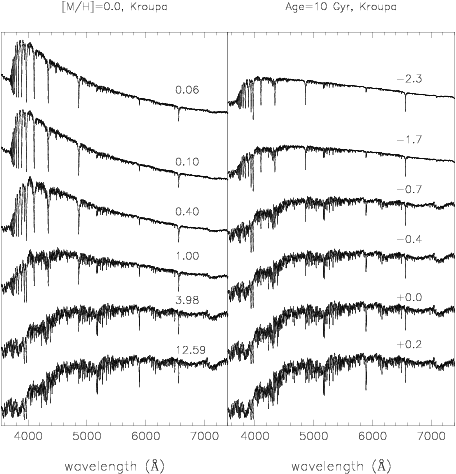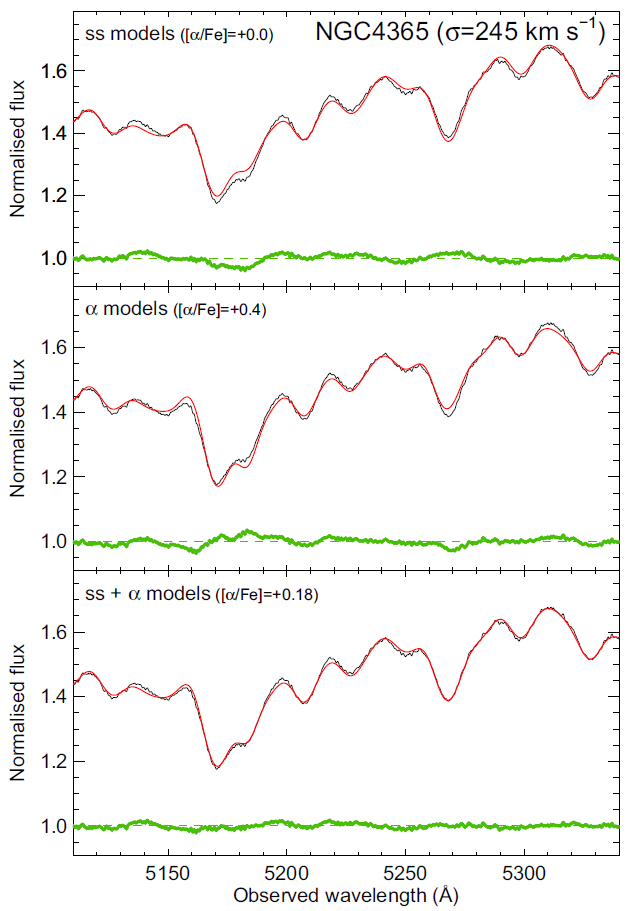MILES models
Tarfiles with all the predictions for this set of models can be retrieved from here:
| MILES models (v11.0) |
We provide advanced tools to facilitate the retrieval, handling and transformation of the SSP spectra here
In this section we present evolutionary stellar population synthesis models based on the empirical library MILES (Sánchez-Blázquez et al. 2006; Cenarro et al. 2007, Falcón-Barroso et al. 2011), which represents a significant improvement (e.g. in its parameter coverage, flux-calibration quality) over previous libraries.
Base MILES models:
In Vazdekis et al. (2010) we developed "base models",  employing the Padova00 scaled-solar isochrones Girardi et al. (2000) and MILES to predict spectra of intermediate- and old-aged stellar populations in the range 3540.5-7409.6Å, at moderately high resolution (FWHM=2.51Å). Following the abundance pattern of the solar neighborhood the computed model SEDs are enhanced in α-elements at low metallicity, whereas around solar metallicity these predictions are approximately scaled-solar. The base models are therefore inconsistent at low metallicities. In addition to the scaled-solar and α-enhanced models, and to the models we published in Vazdekis et al. (2010) using the Padova00 isochrones, we also computed base models employing the BaSTI scaled-solar isochrones in Vazdekis et al. (2010).
employing the Padova00 scaled-solar isochrones Girardi et al. (2000) and MILES to predict spectra of intermediate- and old-aged stellar populations in the range 3540.5-7409.6Å, at moderately high resolution (FWHM=2.51Å). Following the abundance pattern of the solar neighborhood the computed model SEDs are enhanced in α-elements at low metallicity, whereas around solar metallicity these predictions are approximately scaled-solar. The base models are therefore inconsistent at low metallicities. In addition to the scaled-solar and α-enhanced models, and to the models we published in Vazdekis et al. (2010) using the Padova00 isochrones, we also computed base models employing the BaSTI scaled-solar isochrones in Vazdekis et al. (2010).
Truly scaled-solar and α-enhanced MILES models:
In Vazdekis et al. (2015) we further developed our  models based on the MILES library, as well as theoretical stellar spectral libraries used in a differential way, to provide self-consistent predictions at all metallicities. We emphasise that our models can be regarded as self-consistent in the sense that both ingredients, the theoretical stellar spectra and the isochrones are computed with the same overall α-enhancement. To build-up these models we computed fully-theoretical models based on the stellar library of Coelho et al. (2005), with its extension to cool stars of Coelho et al. (2007), to obtain SSPs-based differential spectral corrections. We employed the BaSTI isochrones Pietrinferni et al. (2004, 2006), calculated with similar abundance ratios to the stellar atmospheres, converted to the observational plane using extensive empirical photometric stellar libraries, mostly from Alonso et al. (1996, 1999). To improve the metallicity coverage around the solar value we computed a new set of BaSTI isochrones with metallicity Z=0.024 ([M/H]=+0.15). The obtained theoretical differential corrections are applied to the model SEDs computed with MILES, taking into account the [MgFe] determinations of the library stars of Milone et al. (2011). Therefore, at solar metallicity the scaled-solar models are truly scaled-solar and fully based on MILES, whereas for the α-enhanced models, we apply the differential corrections to the model SEDs computed with MILES. At low metallicities, the opposite is true; the MILES library is intrinsically α-enhanced and we correct the model SEDs using differential corrections to obtain scaled-solar SEDs at low metallicity. We therefore compute self-consistent models for two abundance ratio values: [α/Fe]=0.0 and [α/Fe]=+0.4.
models based on the MILES library, as well as theoretical stellar spectral libraries used in a differential way, to provide self-consistent predictions at all metallicities. We emphasise that our models can be regarded as self-consistent in the sense that both ingredients, the theoretical stellar spectra and the isochrones are computed with the same overall α-enhancement. To build-up these models we computed fully-theoretical models based on the stellar library of Coelho et al. (2005), with its extension to cool stars of Coelho et al. (2007), to obtain SSPs-based differential spectral corrections. We employed the BaSTI isochrones Pietrinferni et al. (2004, 2006), calculated with similar abundance ratios to the stellar atmospheres, converted to the observational plane using extensive empirical photometric stellar libraries, mostly from Alonso et al. (1996, 1999). To improve the metallicity coverage around the solar value we computed a new set of BaSTI isochrones with metallicity Z=0.024 ([M/H]=+0.15). The obtained theoretical differential corrections are applied to the model SEDs computed with MILES, taking into account the [MgFe] determinations of the library stars of Milone et al. (2011). Therefore, at solar metallicity the scaled-solar models are truly scaled-solar and fully based on MILES, whereas for the α-enhanced models, we apply the differential corrections to the model SEDs computed with MILES. At low metallicities, the opposite is true; the MILES library is intrinsically α-enhanced and we correct the model SEDs using differential corrections to obtain scaled-solar SEDs at low metallicity. We therefore compute self-consistent models for two abundance ratio values: [α/Fe]=0.0 and [α/Fe]=+0.4.